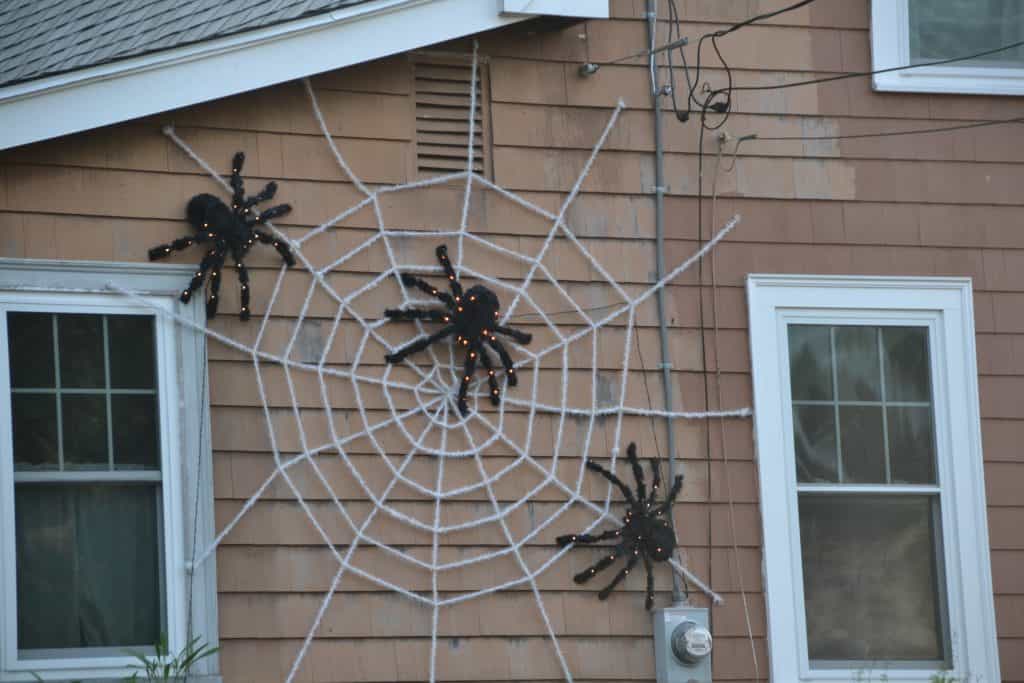Here’s what’s blooming in town this week to make your walks more enjoyable
By Laura Eisener
October has arrived, and Halloween decorations have sprung up in many gardens! Three spooky spiders have begun climbing my neighbors’ house, and a black cat and friends have taken up their places on the lawn! If you stop a minute nearby, you may see Scooby-Doo emerge from one of the jack-o-lanterns on the lawn. I have heard that this animated figure is very unusual, and many of the neighborhood children have their pictures taken next to it when trick-or-treating.
Foliage is beginning to turn, and I always associate Topsfield Fair week with the bright colors of poison ivy (Toxicodendron radicans), since it seems to be climbing many of the trees along Route 1 all the way up to the fairgrounds. Another native vine with colorful fall foliage is Virginia creeper (Parthenocissus quinquefolia). People sometimes confuse the two, since they often grow in similar habitats. A quick way to distinguish the two is that poison ivy has leaves with three leaflets, while Virginia creeper has five on most leaves. However, Virginia creeper is unlikely to cause allergic reactions and rashes. Birds may appreciate the fruits of both, so these vines do have wildlife value even if the poison ivy is rarely appreciated in gardens. Both vines are energetic climbers and can thrive in shade and disturbed areas as well as wild locations. While Virginia creeper may have much to recommend it, especially in fall, it sometimes is inclined to take over more space than we want to give it.
Autumn colchicum (Colchicum autumnalis), sometimes called autumn crocus, is a fall blooming bulb with pinkish or white flowers. It sometimes comes as a surprise to see the lily-like flowers coming up directly from the ground in early October, with no leaves or stems visible. The leaves in fact did appear in the spring, then like many other bulbs would have become dormant by early summer, leaving what looks like an empty spot for most of the summer season. While both the colchicum and a few actual crocus species bloom in the fall, they are not actually closely related. Colchicum belongs to the colchicum family (Colchicaceae), while crocus belongs to the iris family (Iridcaceae).
The flowers now blooming in my front garden were eagerly anticipated, as they were given to me in the spring when Margie Berkowitch was changing her garden beds in East Saugus. Margie and I are both happy they survived the move! They do seem to have some damage to the petals done by slugs, which have become fairly plentiful in this year’s wet season.
Montauk daisy is one of the last perennials to come into bloom in our gardens. While the flower heads with yellow disks and white petaled ray florets are extremely similar to the Shasta daisies (Leucanthemum superbum) that bloom much earlier in the year – usually July, sometimes continuing into August – and to the naturalized oxeye daisy (Leucanthemum vulgare), which peaks in bloom here in June, this Asian plant rarely opens its buds before the beginning of October. the common name refers to Montauk point on the tip of Long Island, N.Y. It is occasionally known as Nippon daisy, Nippon being the Japanese name for Japan, since it grows wild in Japan, growing on cliffs and similar windy, rocky habitats. That explains why it adapted so well to Montauk point, and why it does so well in coastal locations. Unlike the oxeye daisy and the Shasta daisy, the plant itself is somewhat shrubby, with leaves that stay green quite late into the winter even in our climate.
Many kinds of bees and other pollinators, including the small copper butterfly (Lycaena phlaeas), are attracted to the late blooming Montauk daisy. Also known as American copper, or common copper, this is a member of the Lycaenids, or gossamer-winged butterfly family (Lycaenidae). The favorite food plants of the larvae are red sorrel (Rumex acetosella) and common sorrel (Rumex acetosa), although adult butterflies are drawn to a more diverse range of plants, including daisies, thistles and other aster family members as well as unrelated species like clovers. This butterfly can be found in many parts of the northern hemisphere, in Asia, Europe and North America.
Editor’s Note: Laura Eisener is a landscape design consultant who helps homeowners with landscape design, plant selection and placement of trees and shrubs, as well as perennials. She is a member of the Saugus Garden Club and offered to write a series of articles about “what’s blooming in town” shortly after the outbreak of the COVID-19 pandemic. She was inspired after seeing so many people taking up walking.



